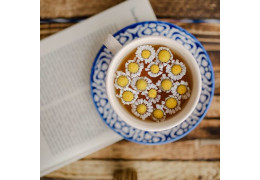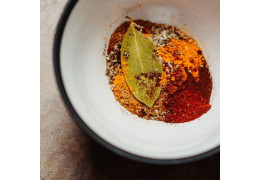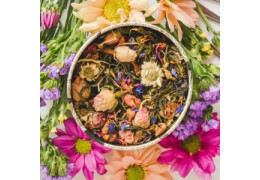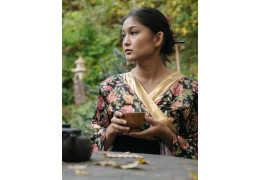Discover oolong teas: origin, taste, benefits, ...
Little known in France, blue tea, or oolong tea, is a refined product. It offers a mild infusion, with little bitterness and theine. Its leaves undergo incomplete oxidation using a variety of processes. The result is a product halfway between green and black teas. Infusions develop a wide range of flavours and aromatic notes. Ready to relax with the jasmine scent of blue tea?
Origin and characteristics of blue teas
In France, tea comes in a variety of colors, including black, green and white. But blue tea remains relatively unpopular. Yet this fragrant tea belongs to the same family and comes from the same plant: Camellia sinensis.
Oolong: why the name blue tea?
The name blue tea refers to the color of the leaves at the time of infusion, not to the color of the liquor. Blue tea should not be confused with the infusion of blue pea or butterfly pea. Blue pea is a member of the Fabaceae family and is not related to the tea plant. The infusion of its flowers produces a liqueur with a beautiful blue color.
Where does blue tea come from?
Oolong tea originated in China, in the Fujian region. Its cultivation has also developed extensively in Taiwan. Today, some thirty countries produce blue teas, including India, Vietnam and Malawi.
What makes oolong tea different from other teas?
The originality of oolong tea lies in the semi-oxidation of its leaves. In fact, the oxidation of blue teas varies between 10% and 80%. These products therefore fall somewhere between green tea (no oxidation) and black tea (oxidized leaves). For blue teas, we use the plant's large leaves, which are more mature and less loaded with tannins and theine. Oolong teas develop a wide range of flavors and aromas, depending on the garden of origin, the leaves selected from the plant, the oxidation carried out and even the way the leaves are rolled.
Oolong teas: from plant to cup
Like other teas, blue tea undergoes various stages of processing.
- The leaves wither for one to four hours.
- Oxidation of the leaves, which lasts a variable length of time. This important stage releases the product's aromatic notes.
- Roasting: the leaves are heated to 200°C to halt oxidation.
- The leaves are rolled into pearls, twists or simply crumpled.
- Final drying at 100°C stabilizes the blue tea by removing the water.
- Packing in bags or tins.
Each country uses its own oxidation technique to obtain a particular product. In China, blue tea oxidation is light, between 10 and 25%. Only the edges of the leaf turn brown, while the core retains its beautiful green color. In Taiwan, oolong tea is oxidized to between 60% and 80%, with the entire leaf changing color.
Brewing and tasting blue teas
It's time to enjoy the taste, aroma and benefits of blue tea infusion. Time for Tea Time!
Infusing oolong tea leaves
To infuse blue tea, use 12 grams of leaves per liter of water, or 3 grams per cup. Infusion takes from 1 to 7 minutes, depending on your preference. The ideal water temperature is 80°C. Boiling water is not recommended, as it ruins the taste of blue tea and the benefits of the plant. Repeated infusions are possible with oolong tea. In this way, you can enjoy different notes with each tasting. In China, oolong tea is infused in a white gaiwan, to better appreciate the color of the liquor.
Taste and fragrance of infusions
Infusion reveals a smooth, bitter-free liquor. The flavors and aromas of blue teas differ according to the garden of origin, the degree of oxidation and the roasting of the product.
- A slightly oxidized blue tea resembles the taste of green teas, with floral notes reminiscent of jasmine, orchid, lilac or peony. The herbal liquor may be overlaid by gourmand, sweet or even buttery aromas. Sometimes, the cups reveal a scent of coconut or vanilla.
- Medium-oxidized blue tea reveals a cup with dominant notes of fruit, honey and spices.
- Highly oxidized blue tea is comparable to black tea. It reveals woody, toasty notes reminiscent of warm chestnut or hazelnut. A taste of ripe or candied fruit emerges (prune, red fruit, grape, etc.). The amber liqueur sometimes reveals a touch of honey.
Blue teas: health benefits?
Enjoying a cup of blue tea at Tea Time also means taking care of your health. In addition to its low theine content, oolong tea infusion releases cis-jasmone and methyl cis-jasmonate. These compounds, with their sweet jasmine scent, are said to have a beneficial effect on anxiety and sleep.
Oolong: a selection of products
Not familiar with oolong teas? Here's a short list of well-known and popular infusions.
- Milky Oolong: its slightly oxidized leaves are placed on top of boiling milk. Milky Oolong tea absorbs the milky fragrance and delicately reveals it in your cup.
- Tie Guan Yin: China's traditional blue tea, with its characteristic floral infusion.
- Bao Zhong: typical Taiwanese blue tea, subtly scented with jasmine.
The family of blue teas can be full of surprises. Would you like to discover the colors and aromas of a blue tea from China or Taiwan? Find your bag or tin among our oolong teas.





